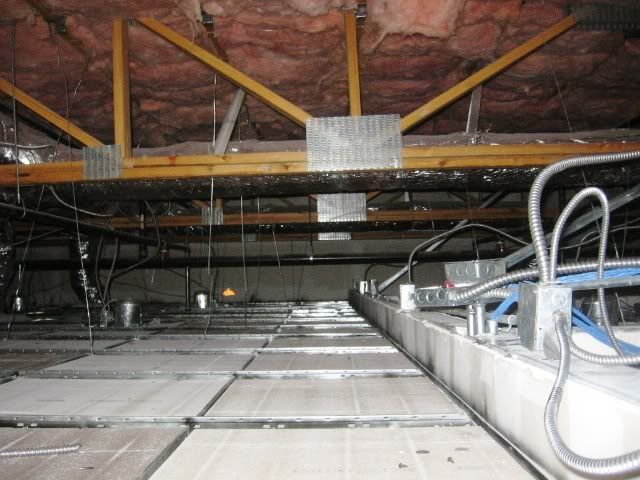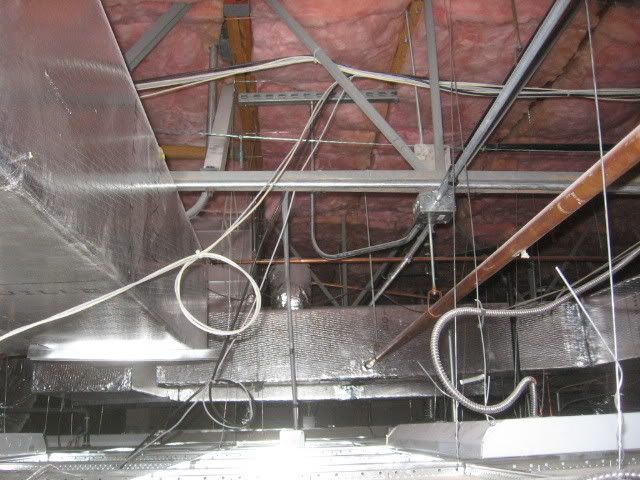Nick
Maybe you should charge for this!! at least to non-members:D
I have one suggestion;
II. The inspector is not required to:
G. Move drop ceiling tiles.
Nick IMO The buyer is paying us to move or lift ceiling tiles we can see many systems ie. Electrical,HVAC etc. Are you sure you want this (G) item excluded?
</IMG>
I did not read the standards …but if this quotation is present it definitely needs removal.
50% of the important aspects of a commercial building are above the drop ceiling.
I also put in my agreement if any tiles are damaged from removal to do the inspection my client is responsible for the replacement costs.
But I have never broken one…fought my a$$ of trying to get some back in, that’s about it.
But they need to be removed in different locations so you can see the whole picture.
Her in AZ many buildings without Package H-C Units on the roof have Air Handlers above the ceiling…a view is mandatory for my inspections.
With respect, I do not agree. I will remove some tiles to look at something, but I do not want to be required to remove every tile.
It does look great though Nick…good work who ever did it.
Every tile?
I’m I missing something?
James
We are not talking about removing all ceiling tiles.
Totally agree Dale!!!
It’s simply great to be a builder in a past life) “A” Mario…![]() …me anyway…
…me anyway…![]()
Hope your doing fine up there…and I’ll see you in Vegas (if you go-to the convention)…![]()
Dale
I will be going to Vegas for sure!!
And I served my entire apprenticeship in the Industrial/Commercial sector of the construction industry. I have installed thousands of square feet of T-Bar.
</IMG></IMG></IMG>
Me too…both…going to Vegas…and installed thousands of sq. ft. of drop ceiling grid/w panels…arrrrrrg…man I hated that…!!!
Oops…I never hated going to Vegas…sorry…had to edit…!!!
Dale
Remind me to tell you about 1000’ of ceiling I did in Daytona,Florida when I see you in Vegas!!
So what happens if there is a structural problem underneath the ceiling tiles that was missed? Is it not better to let the inspector exceed the SOPs by than to open this area for litigation? It is written that it is “not required” to protect you. You should and always exceed the SOPs when you are comfortable doing so to better serve your customer.
remove every other one or every third. Stick your head in there and look around
James I don’t drink.
But I’m having a hard time following you.
I use the SOP as a minimum standard to go with…in case a client just might want to pay for that.
My agreement in writing explains word for word what will be inspected and what will not be inspected.
Depends on what they want to pay for.
Gary in a circumference…removing one out of a circle of 50 is plenty if you have good eyes, binoculars, and a camera.
Actually I can usually see fine for about 40 feet in any direction removing a tile, providing there is nothing hindering my view.
I can inspect above (say) a 40,000 sq ft drop panel ceiling in a hour if everything above is basically in normal condition.
The longest time it took I can remember was a building that had a chiller, there was isolation valves all over hell…that was a mess (leaks)…but other than that one its usually very simple.
Dale,
You go things differently then what we do in central Missouri. I use a large disclaimer after my commercial inspection report, so does other inspectors in my area. On my on home inspection contract I refer to NACHI SOPs, but it also states that I can exceed them. My commercial inspection contract will refer to the Commercial SOPs now. That way I have just a one page inspection contract. But it is also understandable how you do things. So I guess that is where the confusion lies. Have a nice night.
A word of caution when performing a commercial inspection: depending on the size and scope of the inspection, often the PROCESS is as important as the experience. It goes to liability, and as commercial inspections may involve anything from a full-blown study, to a mom-and-pop purchase of an existing small business, there are potentially MANY opportunities to make $$, as well as the reality of a lawsuit for failure to perform.
I teach that there are 3 layers of protection that every inspector should recognize and adhere to. One needs to be extremely careful when “exceeding” the standard, unless mutually defined as to what will be done, and what will NOT be done. This is paramount when DEVIATING from a standard in any way.
Nice photos, Dale, but what do your photos show? Did you actually INSPECT any of the items in the photo? Did your SOP state that this was required, and to what extent? Now that you’ve photographed the event, are you stating that there were no problems found?
Niow, dont get me wrong. I’n NOT picking on you for doing this. I’m just pointing out that exceeding a standard, for no other reason than you think it’s a good idea, can open you up for liability.
Good SOPs protect the consumer AND the inspector… always.
There is no confusion James…I have a one page agreement (word document), but I add what will be inspected and what won’t be inspected, so it might be a 10 page agreement depending on what the client wants inspected.
The SOP means nothing except for a bare minimum inspection and how one goes about doing it, structure, major components and safety are my prime concerns, and always the client to.
I like Nick’s document, everyone involved did a great job.

